In the thriving world of eCommerce, multi-vendor marketplaces are a force to be reckoned with. Last year, Amazon reported $469.8 billion in sales, and Etsy's market value hit $21 billion. Remarkably, 90% of U.S. retailers are marketplaces, and they accounted for 58% of global online sales before the recent surge in eСommerce.
In this article, we will explore all the aspects of multi-vendor marketplace development, offering key insights and strategies to navigate and succeed in this booming industry.
What is a multi-vendor marketplace
A multi-vendor marketplace is an online platform where multiple sellers can offer their products or services to a wide range of customers. It's like a digital shopping mall, where each store is an independent vendor, but everything is housed under one website.
Here's how it works: the marketplace owner provides the digital space (the website), and the vendors sign up to sell their items or services there. This setup benefits both the sellers, who get a ready-made audience, and the customers, who enjoy a variety of options in one place.
There are different types of multi-vendor marketplaces, tailored to various business models and customer needs. Let’s break them down depending on business model, products, and market focus.
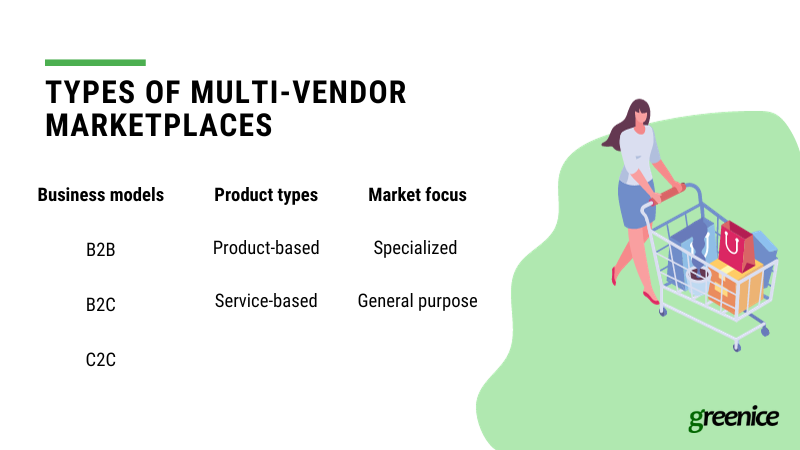
Business models:
- B2B (Business-to-Business): Marketplaces where businesses sell products or services to other businesses. Example: Alibaba.
- B2C (Business-to-Consumer): Platforms where businesses sell directly to consumers. Example: Amazon.
- C2C (Consumer-to-Consumer): Platforms where individuals can sell goods to each other. Example: eBay.
Product types:
- Product-based: Marketplaces focused on selling physical or digital goods. Example: Etsy (for handmade goods).
- Service-based: Platforms offering various services. Example: TaskRabbit (for local services).
Market focus:
- Specialized marketplaces: Cater to specific industries or product categories. Example: Reverb (for musical instruments).
- General purpose marketplaces: Target a wide segment of customers and offer products from multiple niches. Example: Amazon.
Each type offers unique opportunities and caters to different audiences, allowing entrepreneurs to select a model that aligns with their business goals and target market.
Benefits of creating multi-vendor marketplaces
Successful multi-vendor marketplaces are a win-win-win for everyone involved: the sellers, the buyers, and you, the platform owner. These marketplaces simplify the process of buying and selling by creating a single, convenient point for exchanging goods and services. They streamline transactions and build a community of users who can rely on a unified system.
Let’s explore benefits for each party.
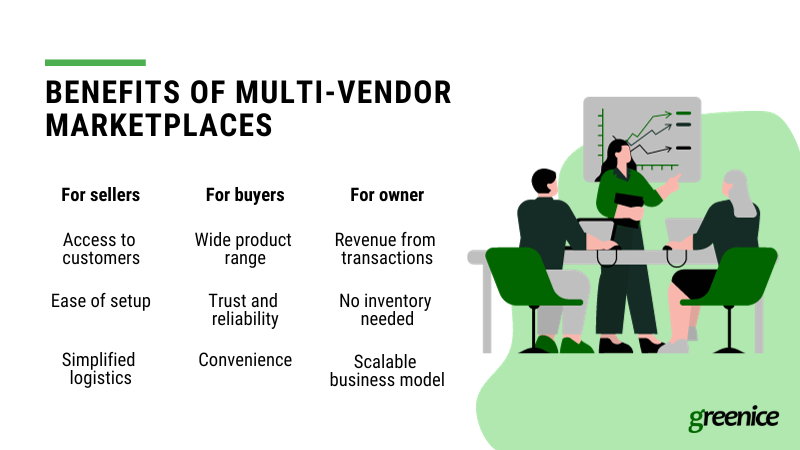
Benefits for Sellers:
- Access to customers: Marketplaces that are hubs for particular products or services attract potential buyers, making it easier for sellers to reach a larger audience.
- Ease of setup: Sellers can quickly create a store and list products, bypassing the complexities of developing and managing a separate eСommerce website.
- Simplified logistics: Some marketplaces offer streamlined shipping processes, reducing the burden of logistics for sellers.
Benefits for Buyers:
- Wide product range: Buyers have access to a vast array of products or services, all in one place.
- Trust and reliability: Purchasing from an established marketplace is often perceived as more trustworthy than buying from individual sellers.
- Convenience: The unified platform makes it easier to compare products, read reviews, and make informed decisions.
Benefits for the Platform Owner:
- Revenue from transactions: You earn a commission or fee from each sale made on your platform, providing a steady income stream.
- No inventory needed: Unlike traditional retail, you don’t need to manage or invest in inventory.
- Scalable business model: As the marketplace grows and attracts more sellers and buyers, your revenue potential increases correspondingly.
Features of multi-vendor marketplaces
Multi-vendor marketplaces are dynamic platforms designed to facilitate seamless interactions between sellers, buyers, and the marketplace administrators. In essence, these marketplaces are more than just eCommerce websites; they're comprehensive ecosystems equipped with a range of functionalities to support diverse needs.
The core of their design revolves around ease of use, efficient management, and enhanced user experience. Key aspects like responsive design ensure accessibility across various devices, while robust security measures protect user data and transactions.
Additionally, these platforms are built to handle high traffic volumes, ensuring smooth operation even during peak usage times. This overarching functionality sets the stage for the specific features tailored to sellers, buyers, and marketplace owners.
Now, let’s explore features for each type of user.
Features for Sellers
These features empower sellers to efficiently manage their presence, optimize their sales strategies, and provide excellent customer service, all of which are crucial for success in a competitive multi-vendor marketplace.
Basic functionality should enable seller journey:
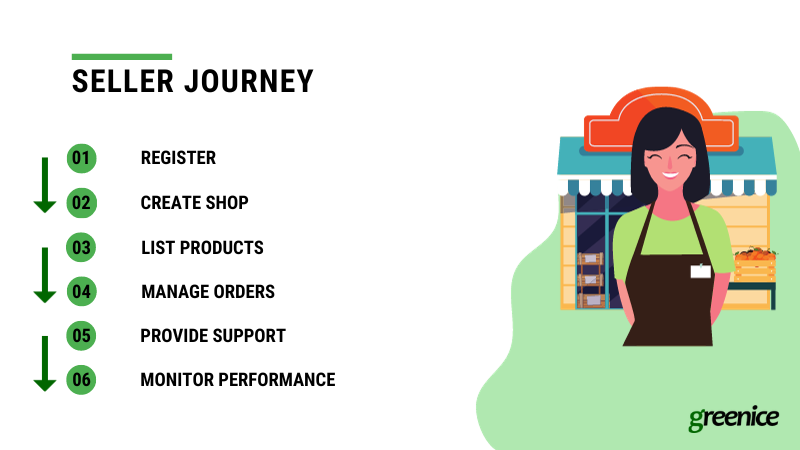
Features to ensure this experience:
- Login and shop creation: Allows vendors to register and build their shops.
- Product listing and management tools: Easy-to-use interfaces for listing and managing products or services.
- Sales analytics: Tools to track sales performance, customer engagement, and other key metrics.
- Automated payment processing: Streamlined handling of transactions for hassle-free financial management.
- Marketing and promotion tools: Features that enable sellers to run their own marketing campaigns within the marketplace, such as discount codes, featured listings, and targeted ads.
- Customer Relationship Management (CRM) tools: Integrated CRM systems to help sellers manage customer interactions, track customer queries, and build lasting relationships.
- Shipping and logistics integration: Tools that integrate with various shipping and logistics providers, offering sellers the ability to manage shipping rates, print labels, and track shipments directly from the marketplace.
- Customizable storefronts: Options for sellers to customize their storefronts within the marketplace, allowing them to create a unique brand presence.
- Product reviews and feedback mechanism: A system for collecting and displaying customer reviews, providing valuable feedback to sellers and helping to build trust with potential buyers.
- Multi-language and currency support: Features that support multiple languages and currencies, enabling sellers to reach a global audience and conduct business in different regions.
- Real-time notifications: Instant notifications about orders, customer queries, and other important updates, ensuring sellers are always in the loop and can respond promptly.
Features for Buyers
These features enhance the shopping experience for buyers, making it more convenient, secure, and enjoyable, which is key to attracting and retaining customers in a competitive marketplace environment.
Basic functionality should enable buyer journey:
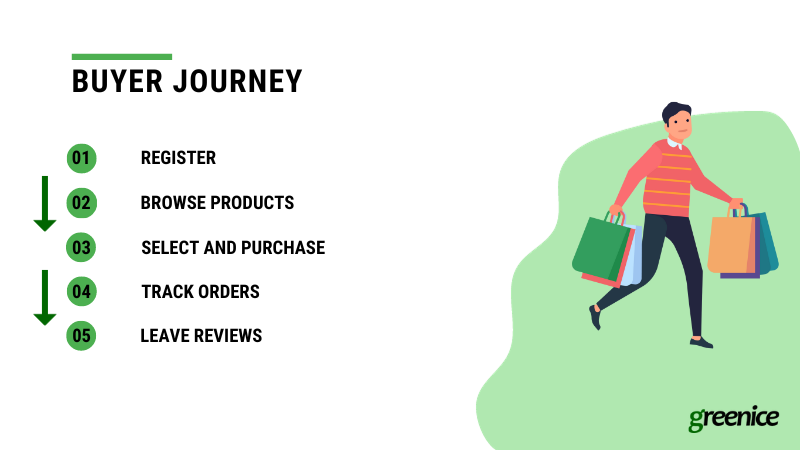
Features to ensure this experience:
- Search and filters: To quickly find desired products or services.
- Profile creation and management: Allows buyers to have a personal account where they can manage their data and purchases.
- User reviews and ratings: Helps buyers make informed decisions based on past customer experiences.
- Wishlist and favorites: Allows buyers to save and revisit items they are interested in.
- Price comparison tools: Tools that allow buyers to compare prices of similar products within the marketplace, ensuring they get the best deal.
- Secure checkout process: A streamlined and secure checkout process that ensures safe and hassle-free transactions.
- Personalized recommendations: Recommendations based on browsing and purchase history, offering a tailored shopping experience to each buyer.
- Real-time inventory updates: Instant updates on product availability, helping buyers make timely decisions and avoid disappointment.
- Order tracking: Features that enable buyers to track the status of their orders in real-time, from processing to delivery.
- Multi-language and currency support: Support for multiple languages and currencies, making the platform accessible and user-friendly for a global audience.
- Customer support and live chat: Dedicated customer support and live chat options for instant assistance with queries or issues.
- Mobile app accessibility: A mobile-optimized platform or dedicated app to enhance the shopping experience on mobile devices.
- Easy return and refund policies: Clear and straightforward return and refund policies to build trust and ensure customer satisfaction.
Features for Marketplace Owner/Admin
These features allow the marketplace owner or admin to effectively manage and grow the platform, ensuring smooth operations, satisfied users, and a sustainable business model.
Basic functionality should enable admin journey:
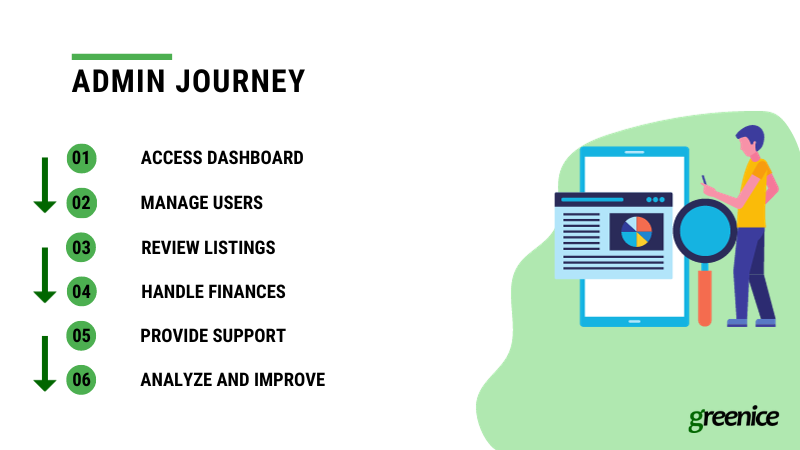
Features to ensure this experience:
- Vendor management: Tools to oversee seller activities, approve new vendors, and ensure quality control.
- Commission management: Systems to set and collect commissions from sales made on the platform.
- Data analytics and reporting: Insightful data to understand marketplace performance and customer behavior.
- User access control and permissions: Features to manage and control access for different levels of users, such as administrators, staff members, or vendors, ensuring security and proper management of the platform.
- Marketing tools integration: Integration with marketing tools and platforms for promotional campaigns, email marketing, and social media management to drive traffic and sales.
- Payment gateway integration: Systems that support integration with multiple payment gateways, offering flexibility and convenience in transaction processing.
- SEO management tools: Tools to optimize the marketplace for search engines, improving visibility and attracting organic traffic.
- Fraud detection and security features: Advanced security measures and fraud detection tools to protect the marketplace from fraudulent activities and ensure a safe trading environment.
- Automated backup and recovery systems: Features to automatically back up marketplace data and provide recovery options in case of data loss or technical issues.
- Customer support management: Tools to manage customer inquiries, complaints, and feedback, ensuring efficient and effective customer service.
- Legal and compliance tools: Resources and tools to help adhere to legal requirements and compliance standards in different regions and industries.
Artificial intelligence
Today, almost everyone is using AI for their business and your marketplace shouldn’t be an exception. AI can be used for the following tasks:
For sellers:
- Dynamic pricing: AI algorithms analyze market trends and competition, providing sellers with real-time pricing suggestions. This not only ensures competitive pricing but also maximizes profit margins by adjusting prices based on demand and supply dynamics.
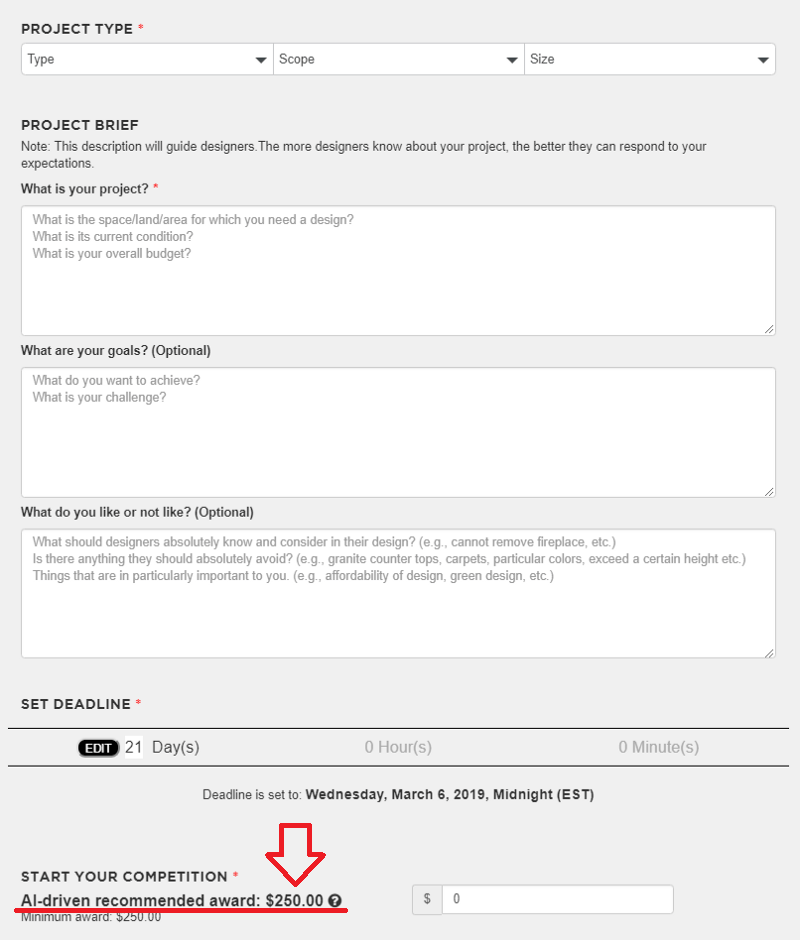
- Inventory management: AI can also assist in inventory management by predicting stock levels needed, reducing the risk of overstocking or stockouts.
- Marketing automation: AI can automate and optimize marketing campaigns, targeting users with personalized ads and offers based on their shopping behavior and preferences.
For buyers:
- Enhanced search: AI significantly improves search capabilities, allowing customers to find exactly what they're looking for with greater accuracy and speed, leading to a more satisfying shopping experience.
- Personalized product recommendations: By analyzing individual user preferences and browsing history, AI tailors product recommendations to each customer. This personalization can increase engagement and sales by showcasing items that are more likely to interest the shopper.
- AI-driven chatbots for customer service: These chatbots provide efficient and responsive support, handling customer inquiries and resolving issues quickly. They enhance the customer service experience by being available 24/7 and offering instant assistance.
For admins:
- Predictive analytics: AI processes large volumes of data to generate insights about customer behavior, sales trends, and operational efficiency. This predictive analysis aids admins in making data-driven decisions to optimize and grow the marketplace.
- Fraud detection: Implementing AI helps in identifying and preventing fraudulent activities by analyzing patterns and flagging suspicious transactions.
Incorporating AI into your multi-vendor marketplace website isn’t just an upgrade; it’s a strategic necessity that can lead to more effective operations, enhanced user satisfaction, and ultimately, a more successful business.
How to make your multi-vendor marketplace profitable?
Making your multi-vendor marketplace profitable hinges on these key strategies: selecting the right revenue model, competing with marketplace giants and capitalizing on their weaknesses.
Choose a Marketplace Revenue Model
Your revenue model is the backbone of your marketplace's financial success. There are several models to consider:
- Commission on sales: The marketplace takes a percentage of each sale made through the platform. Example: Etsy charges a commission on each sale, ensuring they earn revenue as their sellers succeed.
- Subscription fees: Sellers pay a regular fee to list their products or services on the marketplace. Example: Shopify offers subscription plans for sellers, allowing them to create an online store within the marketplace.
- Listing fees: A fee is charged for each product or service listing on the marketplace. eBay often charges a listing fee, especially for certain categories of products or for sellers exceeding a listing limit.
- Freemium: Basic services are free, but additional features or enhanced visibility come at a cost. Example: Alibaba offers a basic free service, with the option for sellers to pay for additional features and greater exposure.
- Advertising and sponsored listings: The marketplace charges for advertising space or for promoting certain listings over others. Example: Amazon offers sponsored product ads, allowing sellers to pay for better visibility for their products.
- Transaction fees: A fee is charged for each transaction processed through the marketplace. Example: Airbnb charges a transaction fee to both hosts and guests, covering the cost of processing the bookings.
- Lead generation fees: In service-oriented marketplaces, the platform charges a fee for connecting customers with service providers. Example: Thumbtack charges service providers a fee for leads received through the platform.
Each of these models has its own set of advantages, and some marketplaces use a combination of these strategies to maximize their revenue. The key is to choose a model that aligns with the marketplace’s goals and provides value to both sellers and buyers.
Compete with Marketplace Giants
Competing with large marketplaces like Amazon or eBay, while challenging, is achievable with the right strategies. Here are some examples of the proven strategies:
- Target a specific niche: Focusing on underserved or overlooked segments can attract a dedicated customer base. By offering a curated selection, you combat decision fatigue and foster loyalty. Tailoring the user experience with niche-specific features can further satisfy unique customer needs. For example, a niche marketplace specializing in eco-friendly products can draw environmentally conscious customers who might find the vast and generalized offerings of Wish overwhelming.
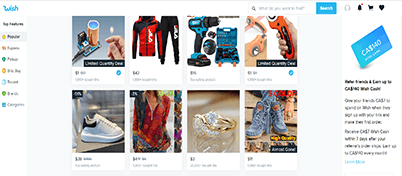
- Enhance customer experience: A user-friendly platform with personalized service can significantly boost customer loyalty. That is the reason why customers love shopping at Zappos. Unlike the often impersonal and automated service on larger platforms like eBay, providing a more tailored and responsive customer interaction sets you apart.
- Prioritize quality over quantity: In contrast to the vast but sometimes low-quality selections on big platforms, curating high-quality, unique items can appeal to those seeking specialized products. This approach not only reduces the overwhelming choices but also builds a reputation for quality. For example, Farfetch focused on this strategy.

Farfetch - Innovate technologically: Leveraging technologies like AI for personalized recommendations or VR for immersive product previews can distinctively enhance your offerings. For example, Amazon Salon offers AR hair consultation for customers. Such innovations can create a unique shopping experience that many marketplaces may not provide.
- Build a community: Engaging with users through forums and social media can cultivate a strong community around your marketplace. A community-driven platform often enjoys higher customer engagement and loyalty, as seen with niche forums and groups on platforms like Reddit. This is much better practice than the faceless approach of many big platforms like AliExpress.
- Offer attractive terms for sellers: Providing lower fees and fair policies can make your marketplace more appealing to a diverse range of sellers. This is particularly important for attracting smaller sellers who may feel marginalized by the high fees or strict policies of larger platforms like Amazon.
- Capitalize on the weaknesses of market leaders: Large marketplaces like Alibaba often suffer from issues due to their size, such as a lack of specialized products or knowledge in certain areas, and impersonal customer service. By offering a more curated and streamlined experience, along with exceptional, responsive customer service, you can address these gaps. Enhancing search and filtering features also helps customers easily find what they need.
- Adopt ethical practices: As consumers increasingly value sustainability and ethical practices, focusing on these aspects can give your marketplace an edge. This approach, which is common for Etsy, not only appeals to a growing segment of environmentally conscious consumers but also builds a positive brand image.

Etsy ethical practices
Strategic positioning of your marketplace and careful selection of your revenue model, will help you create a profitable and sustainable business that stands out in the crowded online marketplace landscape.
Need help with your business idea?
Multi-vendor marketplace software solutions
The right software solution can greatly simplify the process of building a marketplace. With a variety of options available, it's crucial to understand the pros and cons of each to make an informed decision. Let’s explore these options:

White-Label Solutions
These solutions involve using pre-built software (open source or paid) to create your marketplace. They are often available at no or low cost and can be found on platforms like Github. Another option is to buy a license on sites like Envato. They may include tools for building your platform or plugins for expansion.
Pros:
- Cost-effective: Generally, a more affordable option compared to the custom one.
- Fast development time: Using pre-made solutions allows you to create a marketplace much faster than in case with custom development.
- High customizability: This option allows for significant customization and control over your marketplace.
- Feature-rich: Includes a variety of functionalities like product management, order management, and payment processing.
Cons:
- Requires technical expertise: Setting up and customizing the software demands technical knowledge and development time.
- Non-exclusive rights to the code: It wasn’t built specifically for you which reduces customization and security level.
- Limited support: Support options might be scarce, depending on the software and its community.
- Security risks: Not having a unique code, these solutions can be more susceptible to hacks or exploits. This option is less secure than custom development, but not as vulnerable as WordPress.
WordPress and Plugins
Using WordPress and eCommerce plugins, such as WooCommerce and Dokan Multi-Vendor, is another route. This approach is particularly appealing for those with some technical skills who are looking for a lower initial investment.
Pros:
- Low initial cost: Less expensive to start, especially with limited technical resources.
- Short development time: Pre-built nature of this option allows creating websites really quickly.
- Community support: Access to a large, supportive community for assistance and guidance.
Cons:
- The lowest security: Due to their popularity, WooCommerce and Wordpress are hacked the most often.
- Limited features and customization: May not offer as many features as more specialized solutions. Customization heavily depends on plugins and it is hard to make any tweaks.
- Dependency on add-ons: Requires multiple plugins for full functionality, which significantly complicates maintenance.
- Ongoing maintenance: Regular updates are needed to ensure security and functionality of WordPress. But not all plugins are compatible, and using them together can sometimes complicate the update process. In some cases, these compatibility issues might even cause the website to malfunction or become inoperative.
Website builders and extensions
eCommerce building solutions come with a variety of features and tools tailored to the needs of marketplace owners, sellers, and buyers. One of the examples -Sharetribe, which is suited for creating service-oriented or rental marketplaces, even for those without coding skills.
Pros:
- User-friendly: These platforms are generally easy to use, even for those with limited technical expertise.
- Community and support: There is often a large community of users and developers, accompanied by a high level of support for troubleshooting and advice.
- Built-in functionalities: Many builders come with integrated features for handling payments, managing inventory, and overseeing shipping, streamlining these crucial operations.
Cons:
- Costs for additional features: While the basic functions might be affordable, some builders or extensions require payment for more advanced features.
- Limited customization: Depending on the platform, you will face various constraints in customizing the marketplace to your exact preferences.
- Technical maintenance: Setting up and maintaining these platforms, especially when integrating various extensions, can demand a certain level of technical skill.
eCommerce Platforms
These are specialized solutions for eCommerce which might require some coding. An eCommerce platform serves as a content management system (CMS) and commerce engine for websites, handling product catalogs, purchase registrations, and user relationship management for businesses of any size, type (B2B or B2C), and whether selling physical products or remote services. Among these options are Magento with Marketplace Extension and Shopify Plus with Marketplace Apps.
Pros:
- Streamlined operations: eCommerce platforms simplify managing product catalogs, processing purchases, and maintaining customer relationships.
- Scalability: These platforms can usually scale with your business, accommodating growth in products, customers, and sales.
- User-friendly interface: Many platforms offer intuitive interfaces, making it easier for businesses to manage their online store without extensive technical knowledge.
- Integration capabilities: They often integrate with various tools and applications, such as payment gateways, shipping services, and marketing tools, providing a cohesive ecosystem for business operations.
Cons:
- Costs: While some platforms are free, others can be expensive, especially when adding premium features, customizations, or scaling up operations.
- Generic design and functionality: Some platforms may offer limited customization options, leading to a generic look and feel of the online store or limited functionality.
- Complexity: As businesses grow, their needs become more complex, and managing various aspects of the platform can become challenging without technical expertise.
- Security concerns: Handling sensitive customer data requires robust security measures, which can be a concern, especially for smaller businesses with limited resources.
Custom Development
Unlike using pre-built eCommerce platforms, this approach allows building features, design, and functionality from scratch. Custom development is best suited for businesses that require specific features and have the budget and time to invest in a unique solution.
Pros:
- Tailored solutions: Custom development ensures that every aspect of the platform, from user interface to functionality, is crafted to meet the unique needs of your business.
- Scalability: A custom-developed platform can be designed with scalability in mind, allowing for future growth and changes in the business model.
- Optimized performance: Since the platform is built for specific needs, it can be optimized for better performance, speed, and user experience.
- Control over security: Thanks to exclusive code ownership, custom platforms have enhanced security measures tailored to the specific needs and risks associated with your business.
Cons:
- Higher costs: Custom development is typically more expensive than using pre-built solutions, both in initial development and ongoing maintenance.
- Time-consuming: Developing a platform from scratch takes more time, delaying the launch of your marketplace.
- Requires technical expertise: You need access to skilled developers who understand your requirements and can build the platform accordingly.
Here is a comparison of these solutions:
| Solution | Customization | Security / Reliability | Required tech expertise | Required time and money |
| White-label | Highly customizable | Quite secure | Requires expertise | Medium |
| WordPress | Limited | Very vulnerable | Requires some skills | Low |
| Website builders (e.g. Sharetribe) | Limited | Average | Requires some skills | Low |
| eCommerce platforms (e.g. Shopify) | Limited | Requires additional security measures | Requires some skills | Low |
| Custom development | Fully customizable |
Secure | Requires expertise | High |
Choosing the right software solution for your multi-vendor marketplace is a balance between your technical capabilities, budget, and the specific needs of your marketplace. Understanding these pros and cons is essential in selecting a solution that aligns with your business goals and provides the best experience for your users.
How much does it cost to create a multi-vendor marketplace
Multi-vendor ecommerce website development cost can vary widely based on the chosen development approach. We will give a ballpark estimate for two types: white-label and custom solutions.
White-Label Solutions
This approach is based on utilizing pre-built, ready-to-deploy marketplace platforms. It is less expensive and quicker to launch compared to custom solutions, but at the same time it is a less flexible option. Some degree of customization is possible, but extensive changes can significantly increase costs.
The price can range from $5,000 to $15,000, varying based on customization and added functionalities and integrations.
Custom Solutions
This approach involves developing the marketplace from scratch. It offers unique features and complete control over the platform.
The cost is primarily influenced by two key factors:
- Complexity of features: The level of sophistication in the features determines the overall cost. Advanced features, such as AI-driven recommendations, intricate user interfaces, or comprehensive analytics tools, require more development time and expertise, thus increasing the cost. Essentially, the more complex and feature-rich your marketplace is, the higher the investment required for its development.
- Development team's hourly rate: This rate is largely contingent on the team's experience and geographical location. For instance, development teams based in North America or Western Europe typically have higher hourly rates due to the greater labor costs in these areas. On the other hand, teams from regions with lower labor costs might offer more affordable rates, though this can sometimes come with challenges in terms of time zone differences and communication barriers.
The team's expertise and track record also play a crucial role in the rate, as more experienced developers may command higher prices due to their advanced skills and reliability.
At Greenice, the price starts from $15,000 for a basic functionality.
For entrepreneurs, it's crucial to balance cost, quality, and functionality. Factors such as the desired level of customization, regional cost differences, and the complexity of features all play a role in the overall investment required. Assessing these aspects carefully will guide you in selecting a development approach that aligns with both budget and business objectives.
Our experience
At Greenice web development company, we specialize in creating secure and innovative multi-vendor marketplaces. With a myriad of successful projects, our experience spans a range of industries and client needs.
A leading review website in New Zealand, NoCowboys serves as a platform for finding reliable home service providers. Our redevelopment of their platform focused on enhancing the codebase, CRM, and user experience, significantly improving its efficiency and functionality.
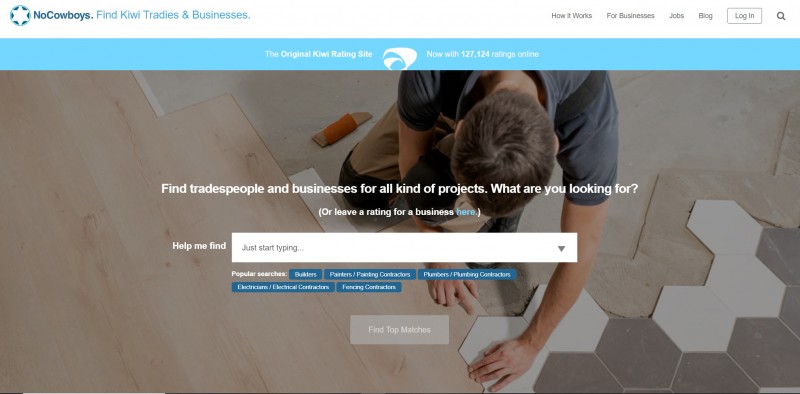
BizSaleByOwner
Operating as an innovative marketplace for business sales, BizSaleByOwner offers features to facilitate the sale of businesses and connect users with expert counselors. Starting from an MVP, we expanded the platform to include comprehensive support for both buyers and sellers in the business trading process.
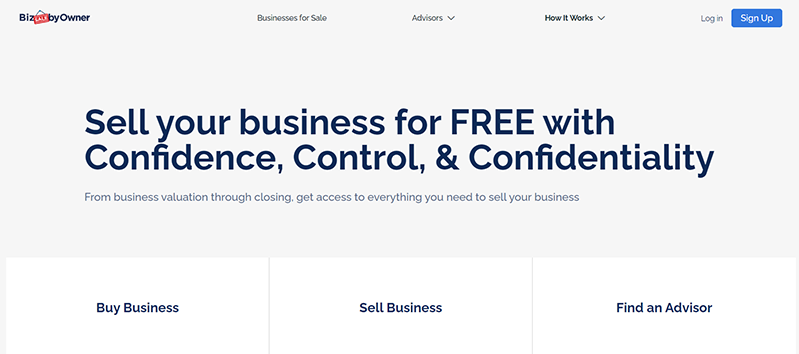
An interior design contest marketplace, Arcbazar connects clients with designers. We overcame challenges such as tangled code and lack of scalability, adding features like a machine learning-powered award suggestion system and shop tagging in design projects, thus enhancing the platform's international user experience and engagement.

A Multi-Vendor Marketplace
We worked on another project for our client - a B2B marketplace similar to Alibaba, catering to both buyers and sellers. According to the client's idea, buyers can view listings for wholesale orders and request custom quotes, while sellers can list both goods and services, with options for special offers to existing clients. The platform features dual-purpose accounts for both buying and selling, and it is monetized through a commission model, taking a percentage from the seller’s revenue per transaction.
Conclusion
Starting a successful multi-vendor marketplace involves various factors, from choosing the right software solution and features to offering something that your customers crave.
In this article, we've explored the world of multi-vendor marketplaces, covering their types, advantages, and monetization strategies, as well as examining the pros and cons of different development approaches, including custom and white-label solutions.
Based on our extensive experience at Greenice, while building successful marketplaces, the most important thing is to choose the right development approach and incorporate advanced features like AI to make your marketplace stand out. Whether you're building a new platform or enhancing an existing one, the focus should always be on delivering value to every user—sellers, buyers, and administrators.
If you're aiming to create a standout marketplace, Greenice is here to assist in your journey.
Need a multi-vendor website development company?
Rate this article!
5





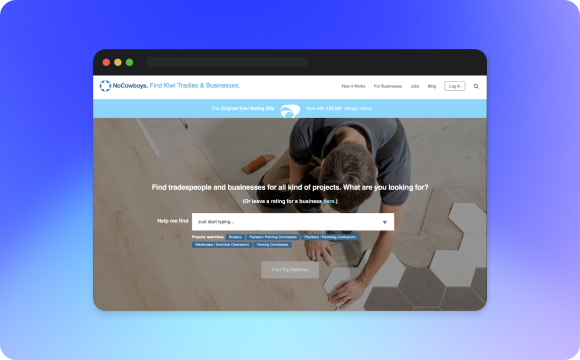



 Sign in with Google
Sign in with Google
Comments (0)